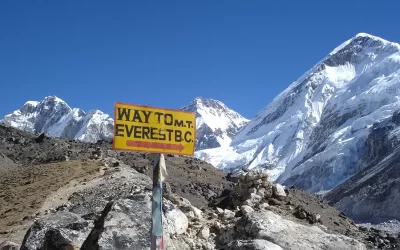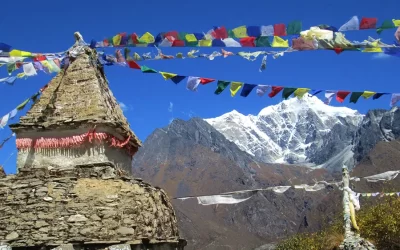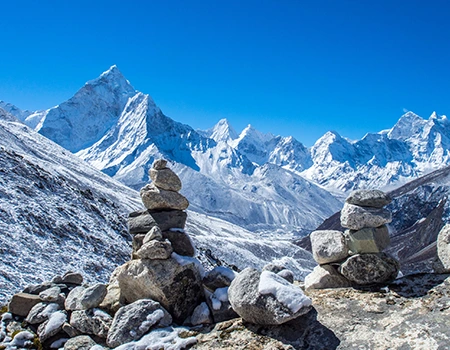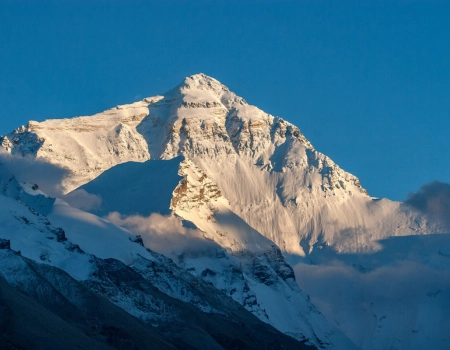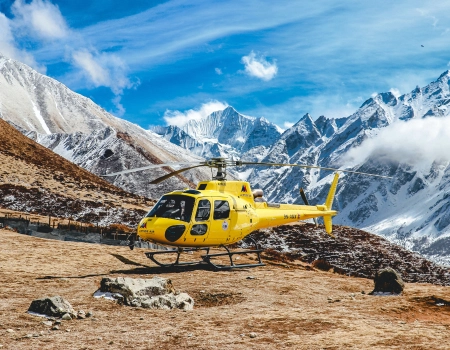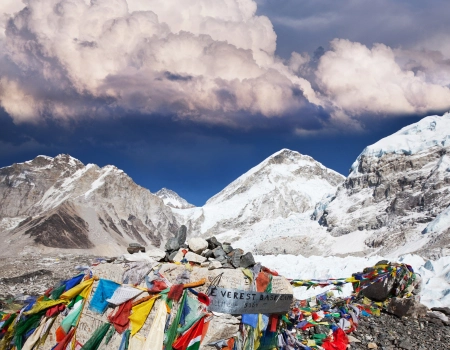Everest Three Passes Trek Highlights
- Witness the mesmerizing view of Mount Everest
- The lifestyle of the Sherpa community, their foods, culture, and traditions they do follow
- Ancient stone carved -mani on the route to the highest pass Trek
- Unique flora and fauna
- Visiting Tengboche monastery, with its strong bond of spirituality
- Stay at Namche Bazaar which is the Gateway to Everest Base Camp Trek
- Exchanging the cross-culture between the Local community and the Travelers during your acclimatization day
- The best place to view sunrise/sunset is on the top of the Himalayas mainly on Mt.Everest
- Experience the mesmerizing views of the mountains during the Everest Three Passes Trek
- During the Everest Three Passes, you will pass through the highest pass in the world
Trip Info
Everest high Three Passes Trek offers a wide range of opportunities to all outdoor lovers, seekers all around the globe, and those willing to have thrilling and adventurous experiences in their lifetime.
Trekking through the highest passes of the Khumbu region is the most demanding and famous trekking destination for trekkers.
Everest Three Passes Trek takes you over 5000m above sea level, offering you the best view of the snow-capped Himalayas all around.
Everest Three Passes Trek of Everest region, makes your adventure experience well worth crossing the highest and most popular passes, Renjo-La (5,417m), Cho-La (5,535m), and Kongma-La (5,420m).
The mesmerizing view of the highest mountains, Khumbu Glacier world’s highest glacier, and the unique settlement of the ancient Tibetan community make the trek more exceptional.
The Everest Three Passes Trek offers you the best way of exploring the unique settlement of the Sherpa community, the ancient (century) Tengboche Monastery, and hidden parts of Dingboche.
The majestic snow-capped view of the highest peak on land. Mt. Everest, Mt. Choyo, Mt. Makalu, and many more Himalayas in front of you create good bonds with you in the high elevation of the world.
Creating memories, having fun with travel mates, and exploring different corners of the Three Passes, along with a good fit and healthy body to beat the trails to the highest Everest Three Passes Trek.
Besides good and well-managed health the trekker’s mentality should also be super-managed to tackle all the obstacles in the high altitude.
Our professionals and highly qualified guides and instructors from Blue Lake Adventure assist you in making your passes across the highest Everest Three Passes Trek In the Everest Region.
The Everest Three Passes Trek is most famous and popular for its majestic Himalayas view, the settlement of the Sherpa community lures more visitors to the region. While Sagarmatha National Park also adds more attractiveness to trekkers, who are willing to experience more flora and fauna of the high Himalayas during the Everest Three Pass Trek.
Everest Three Passes Trek Overview
The Everest Three Passes trek takes you through the dense forest of flora and fauna with mesmerizing views of snow-capped Himalayas and the highest passes of the world to cross.
The thirty-minute flight to Lukla is the gateway to the Everest Three Passes Trek. Reaching Lukla, we trek to Namche Bazaar, the hub for trekkers, a gateway to the giant Himalayas via Phakding.
We make our way towards Tengboche, Dingboche, and Chukhung till we reach Kongma-La pass which is the first part of our journey in the Himalayas. Kongma-La Pass is situated at an altitude of 5,535m which offers the best view of the Himalayas and Mt. Everest.
Everest High Three Passes Trek is dreamy and breathtaking to all outdoor lovers and a lifetime experience, memories that do not come hand quickly. It requires good health and a walking pace too during Everest High Pass Trek.
What are the Everest High Three Passes?
The following are the Everest three passes Trek that you will be traveling:
- Renjo-La Pass (5420m)
- Cho-La Pass(5420 m)
- Kongma-La Pass(5535 m)
Everest Three Passes Trek is not considered luxurious trekking this trek is for your lifetime memories and stories to share with your friends, and loved ones and also with your coming new generations about your first trekking in the Himalayas of Everest Region.
While trekking to Everest Three Passes Trek, the accommodation will be mainly on a sharing basis for all the nationalities in the Hotel/Tea houses. The room is comfortable with good peaceful sleep during your trek to Everest Base Camp.
On the other hand, you can enjoy the majestic view of the Himalayas from your own room’s window which will be your lifetime memories that won’t fade away from your heart. The Internet, charging mobile phones, and taking hot showers will be available on a small amount of charge.
You will be enjoying the Himalayan lifestyle by drinking ghee tea in the Himalayas which makes you feel warm and good to explore more within the region.
If you are having a lack of time to trek Everest Base Camp while you wish to see Mount Everest once in your lifetime then we also manage Everest Base Camp Helicopter Tour.
Upon arrival at the Airport In Kathmandu, our representatives will welcome you and transfer you to the Hotel.
You may buy the trekking gear and equipment that you need during the trek. You will meet the guides who will brief you about the trekking destination.
After a few hours of rest, you may explore Thamel City with a huge crowd of people and many shops around the city.
Tonight, we all will enjoy our dinner together and chit-chat about our upcoming trekking with guides and instructors.
Today, early in the morning we will leave KTM around 1:30 AM and drive to Manthali Airport in Ramechhap district for three to four hours to catch our flight to Lukla.
Flight to Lukla from Manthali Airport takes around 30-35 minutes. In Lukla, we will meet our porter staff and hand them all our baggage. We get packed and start our trek toward the northwest of Lukla on the start of the famous EBC Trail.
we soon enter the dense forested Dudh Koshi River and wind way up to the valley. We kept on trekking by putting the river on our left side.
We will spend our overnight at the riverside village of Phakding. It is a settlement of the Sherpa community lower in altitude than Lukla, so don’t need to worry about altitude problems.
Today’s trek continues with the Dudh Koshi River and will enter Sagarmatha National Park.
The interesting part of today’s hike is that we pass across the suspension bridge full of different colored Tibetan flags hanging on the bridge.
After crossing the suspension bridge we start climbing the steps towards Namche Bazaar. Change in altitude will be seen while reaching Namche.
Reaching Namche one can explore nearby and may enjoy the hot coffee in the teahouse.
Today we stayed in Namche Bazaar to adjust to the environment of the Himalayas to get rid of high altitude problems. There are lots of places to explore in Namche such as Museums, stupas, and a Monastery.
Also, hike to Hotel Everest View for a beautiful view of Mt.Everest and many more high peaks can be witnessed having coffee with your members.
We head in the northeast direction up the Pheriche Valley to reach Tengboche. We will be walking on a wide and long smooth path while our trail descends to a flat floor valley to reach Tengboche.
Tengboche offers visitors a majestic view of the Himalayas such as Everest, Lhotse, Makalu, Amadablam, and Thamserku.
Tengboche monastery is a Tibetan Buddhist Monastery that is the largest in the Khumbu region and it is worth a visit it also contains a 20-foot Buddha sculpture, also wall hangings, and more.
We climb up the Imja Khola valley, crossing the dense forest and enjoying the majestic views of the Himalayas while Amadablam and Island Peak will take a breath for a while with its beauty in front of us.
Before reaching Dingboche there is a fork in the road, those travelers going to classic EBC follow left towards the village of Pheriche.
While we move forward to the right, crossing the suspension bridge and stepping upwards to reach Dingboche.
If you are good and wanna explore more as you reach Dingboche, we suggest you hike to Nangkartshang Peak from where you may have a mesmerizing view of the Himalayas on the surroundings such as Amadablam, Lhotse, and Makalu.
Today we will explore the Dingboche-the Sherpa settlement in the high Himalayas.
Looking after the lifestyle of the people, inter-cultural change, and trying the typical local dish.
Today, we will hike to Nangkartshang Peak from where you may have a mesmerizing view of the Himalayas in the surroundings such as Amadablam, Lhotse, and Makalu.
Keep on spending time in the viewpoint have some snacks & stare at the mountains and start descending down to Dingboche.
Today we have an easy and short trek to reach Chhukung. Usually, the paths are wide and smooth following the Imja Khola.
The paths are less crowded as compared to those around Tengboche. The stone rugged path will be encountered while reaching Chhukung.
Chhukung is a small settlement or Tea house to serve the travelers willing to pass Kongma-La pass and Island Peak.
Today, we tackle our first Pass Kongma-La which is the highest pass and the most challenging which is higher than Everest Base Camp.
Today is the day, we need to concentrate more, on crampons, and trekking poles while passing as our paths are rocky and uneven. There are good and smooth paths while ascending.
While reaching the Kongma-La pass top, you are rewarded with the most beautiful; and breathtaking Himalayas view.
Descending is trickier than ascending while the routes are slippery, so walking at your pace is enough, no need to rush while descending.
Near the end of the pass, we cross over Khumbu Glacier – the largest glacier in Nepal.
Crossing the glacier we head towards Lobuche for an overnight stay. While again we link with classic EBC trails.
Today, after a heavy breakfast, we head to Everest Base Camp. Everest Base Camp, from where the expedition lovers leave for their expedition. Different people and huge crowds may be seen in EBC.
After reaching EBC we descended down to Gorak Shep for our overnight stay. Gorak Shep was the original EBC used by the Swiss mountain climber to summit Mount Everest.
First, we head towards Kala Patthar, known as “Black Rock”, after our breakfast. Which is not massive but the high altitude and very tiring.
Kala Patthar is the best destination and is on everyone’s mind to be there.
It offers the best panoramic views of the high Himalayas. The top peak of Mt.Everest can be witnessed from Kala Patthar.
As we see the high Himalayas we now join the EBC trail we pass via Lobuche and later we head to Dzongla Village.
Now it’s our time to cross our second pass which is Cho -La Pass at an altitude of 5,420m. It is the most challenging and the toughest pass as we have to pass Cho-La glacier while climbing up. Reaching the top of the pass offers us mesmerizing views of snow-capped Himalayas from all around. While descending the route is steeper than ascending.
After crossing the pass, we reach the small village of Thangnak where we spend our overnight.
Leaving Thangnak, we head towards Gokyo Lake after breakfast early in the morning. The path to Gokyo is smooth and wide while we need to cross Ngozumpa Glacier on the top of Gokyo village.
Gokyo is a small village with its golden gem. The village sits on the lap of Cho Oyu the sixth highest mountain.
The Gokyo Lake is a holy lake for Buddhist and Hindu people where during the month of August huge devotees trek to make their wish.
Day 14: Gokyo rest & visit the fifth lake then climb Gokyo Ri (5,357m) Duration: 5-6 hours.
Today we will explore the Gokyo lake and hike to Gokyo Ri following linear paths. Reaching Gokyo Ri, mesmerizing view of Gokyo Lake on the north. While on the southwest we see Renjo-La pass which we pass tomorrow. In the other direction, we see different Himalayas taking.
Today we tackle our third and final pass of the Everest Three Pass Trek. While passing the Renjo-La Pass the local people with Yak transporting the goods can be seen.
While leaving The Gokyo Lake behind and we start climbing uphill the View of Gokyo Lake and Ngozumpa Glacier looks more beautiful and gets more perfect while climbing high.
The path to Renjo-La pass is rocky, and technical and needs more concentration making another good use of our trekking poles.
While descending down the routes are slippery and need more concentration and overnight we stay at Murlung.
We will start our trek beside the Bhote Koshi River. We pass via Thame, the birthplace of mountaineers. Thame monastery is best to visit if you do have enough time.
We head towards Monjo via Namche Bazaar for our overnight stay. We will enjoy our successful trip in Monjo with our mates tonight.
Upon returning back, we head to Lukla after breakfast from Monjo. Today, saying goodbye to all the high mountains and bringing good memories, we trek back to Lukla for an overnight stay.
Today, we fly from Luka to Mnthali Airport for 45 minutes and drive to Kathmandu. Directly transfer to the Hotel, take a rest and will meet for farewell dinner tonight.
The staff member will leave you at Tribhuvan International Airport. To reach TIA, it takes 30 minutes from the Thamel area depending on the traffic.
You may also join the next group for another destination in Nepal.
What are included in Everest Three Passes Trek?
What's Included?
- Airport Pick up and drop free of Cost
- Kathmandu – Manthali Airport- Kathmandu round trip by Private vehicle
- Manthali Airport- Lukla- Manthali flight ticket
- Best available lodge accommodation during the trek twin sharing
- All standard meals full board with tea/ coffee (Lunches, Dinners, and Breakfasts) during the trek
- Government licensed holder Blue Lake Adventure experienced trek Guide and porter ( Every two trekkers 1 Porter Carry 11 kg Baggage
- Guide and porter include their salary, meals, lodging, and insurance
- Water purification tablets for safe drinking water during the
- Sagarmatha National Park entry fee
- (TIMS) card Trekkers Information Management System
- The Permit of the Local Government and Sagarmatha National Park
- Everyday Seasonal Fruits
- Down Jackets, Sleeping Bag, Blue Lake Adventure T-Shirt, and Annapurna Base camp map ( Down jacket and Sleeping bag to be returned after the trek )
- Medical Kits
- All Nepal Government taxes and office expenses
- Rescue operations in case of complicated in funded by travel insurance
- Blue Lake Adventure Certificate after the successful trek
- Farewell Dinner in Kathmandu
- Airport drop
What's Excluded?
- International Flights ticket
- Nepal Entry visa fee
- Visa Cost on Arrival in International Airport Kathmandu (15 Days, $ 25- $30 30 Days – $40-50, and 90 days- $100-110)
- Extra luggage (limit is 12 kg per trekker)
- All Accommodation and meals before and after the journey in Kathmandu
- Lunch and dinner in Pokhara and Kathmandu
- Personal Expenses (Snacks, ( tea/ Coffee) cold drinks, Alcohol, Boil water Wi-Fi, hot shower, battery re- Charge, telephone call, and extra porter
- Personal Gear and clothes
- Personal Trekking equipment
- Tips, Guide, Porter, restaurant, Driver
- Additional Costs like delays caused due to circumstances beyond our control, for example- itinerary modification, change of government policy, Strikes, illness landslide, etc
What are the permits required for Everest Three Passes?
The Nepalese government issues permits to all tourists of all nationalities who intend to hike to Everest Three Passes Trek. While the permit fee is collected by the Nepali government, either locally or centrally, it will be used to promote the conservation of wildlife species and the Himalayan ranges.
All hikers must have permission to visit any national parks, restricted areas, or trekking zones in the Everest region. The entry permit is the same as for other national parks and conservation areas in the nation, though it may vary depending on the region’s trekking paths according to local government norms and regulations.
The amount collected will be taken for the sustainable development of the trekking trails in the Everest region for the ease and proper way to hike for the trekkers. Which will also create employment opportunities for the local community people of the region.
Khumbu Pasang Lhamu Rural Municipality Entrance Permit
The local government of Khumbu Pasang Lhamu Rural Municipality started collecting the entrance permit of NPR 2000 directly from all foreigners trekking to the Everest region on the 1st of October 2018 AD replacing the TIMS card(Trekkers Information Management system).
While it’s not possible to pay the local government tax from Kathmandu, if a trekker is traveling from Lukla then you may get it at Lukla. On the other hand, if you’re traveling from Jiri or Salleri then it is possible at Monjo while trekking to the region of Everest.,
Note: Additional permit is required if you are traveling from Jiri, more information is below:
Sagarmatha National Park Entry Permit
It is the existing rules of the National Park under the rules of the Nepal government. The entry permit of NPR 3000 per person should be paid while entering the Sagarmatha National Park. The national park entry permit is easily available at the Nepal Tourism Board in KTM.
Additional permit required
While you are traveling from Jiri to Everest Three Passes trek by roadways you will be more eligible to pay NPR of 3000 per person for the Gaurishankar Conservation area entry permit fee. The Gaurishankar Conversation Area entrance fee can be paid at the Kathmandu office of the Nepal Tourism Board.
Everest Three Pass Trek Cost
The cost for trekking in Everest Three Three and all the trekking destinations in the Everest region varies according to the service of trek you are willing to do. Usually, the normal trekking rate starts from USD 1199 to USD 4499 for budget and luxurious treks respectively. Mainly, the cost of permits, transportation, and visa fees In Nepal that you can’t cut off. While you may look at consideration of accommodation, insurance and the type of travel you are looking for.
The following are the basic pricing to do a trek in Everest Highest Passes:
Permits: While trekking to the Everest Region, mainly Sagarmatha National Park permits and Khumbu Rural Municipality permits. Refer to the above Permits.
Nepal Visa: You require a visa while entering the Nepal territory which costs $30,$50 depending on the length of your stay.
Food and Accommodation: The cost heavily relies on Food and Accommodation as per your preference while traveling to Nepal. affordable guest houses, hostels along luxurious star hotels are available as per your requirements which may cost you $15 and $25 respectively. The same applies on the trek to Everest Three Pass while you are trekking to Highest Passes in the Everest region.
Transportation: The highest cost, while planning for travel is Transportation. So suggest you book your flights, and vehicle in advance before the date of travel.
Everest Three Pass Trek-Terrain, Altitude, and Elevation
Everest Three Pass Trek is a high-altitude trekking destination for those who are willing to explore the Everest region. Before starting to hit the trails of the Everest High Passes Trek- you need to have some knowledge of the Everest region in your mind.
While trekking to Everest Three Pass trek, good health also plays a vital role. A good fit body is required for trekking in the Everest Region.
Though based on highly qualified guides and instructors, we grade Everest Three Pass Trek as an advanced trekking route and the best trekking destination for outdoor lovers.
While trekking to Everest Three Passes hike, it is good news for you to know that you don’t need any special experience, and mountaineering technique is required.
Terrain
The Sagarmatha National Park’s trekking path to Everest Three Pass trek passes through an area with alpine surroundings, a dense pine and ironwood forest, and also becomes muddy when it rains.
The first part of the trip from Lukla to Namche Bazaar is simpler, although it might be challenging to climb the steps to get there. The difficulty of the steps increases as you hike toward Tengboche. You will encounter a lot of suspension bridges as you explore the Himalayas in the Everest region.
After a few days of walking, the pathways level off and get wider, and you may see the flat valley of the Everest region and the captivating Himalayas from all sides as they stare at you.
You will start exploring from where you will no longer be surrounded by trees. From there, you will leave the shade of the trees and start your exploration of the stony trail leading to Everest’s Highest Pass in the Everest Region.
Altitude and Elevation
How high is the journey to Everest Three Pass? The largest obstacle that faces all outdoor enthusiasts as they hike to their destination is altitude. this trek you will be at a height of 55354M from sea level, where all the tree lines will be crossed near Dingboche.
The thirty-minute flight will land you in Lukla (2651M ) and the remaining balance of the distance should be covered with your legs. To avoid being affected by the attitude in the Himalayas while traveling, our highly qualified guide will aid you. However, cooperation with our team is crucial for this.
You run the danger of developing acute mountain sickness (AMS) when hiking to Everest Three Pass. Several impacts at high altitudes are caused by AMS, which appears to be most active at an elevation of 2500 meters above sea level.
The elevation gain on the trip to Everest Three Pass Trek is more than twice that of the height where AMS appears to be active. The two days of adequate acclimatization should be spent ascending to high peak vistas and descending to a lower altitude for the night to assist the body in adapting to the Himalayan environment.
Drinking lots of water during your trek to Everest High Pass helps to avoid AMS. while hitting the high elevation, communicate with your guides for oxygen and the medicine kit ready which might be useful for you to reach your destination.
Food On The Everest Three Passes Trek
Don’t be embarrassed to ask for more food at the tea house when you are on the Khumbu region’s trekking trail to Everest Three Pass. Although all the tea houses on the route to Base Camp have identical meal choices, prices may vary depending on where the tea house is located. The cuisine will be better for you to eat with your traveling companions and will more fully satisfy your appetite.
The following are the most common dishes and most popular among trekkers:
- Dal Bhat: Dal Bhat is more famous among all the trekkers in Nepal. Dal Bhat is super delicious with spicy lentils, curry with vegetables, and a special Nepali recipe for chicken curry, and the flavor of pickle will amaze you while trying the dal bat during your trek. while In Nepal, it is said that – dal bhat power 24 hours – means having dal bhat during your trek makes you full for 24 hours, which will help you to hit more emails to the summit.
- Eggs and Fry Rice: Mixed with onions and ginger during your trek will help your appetite which comes full of rice mixed with vegetables and omelet as per your order.
- Shyakpa(Sherpa stew): A mixture of vegetables such as carrot, radish, puck: echoey, spring onions, and potatoes with spicy soup will help you to be warm and more full during your trek in the Himalayas of the Everest Region.
- Be-chiya (Tibetan Ghee Tea): The tea which is a combination of yak ghee, Himalayan salt, and the flavor of sunpati plant flower tea helps trekkers to be fully warm and helps to get rid of altitude sickness.
Accommodations on Three Passes Trek
All of your lodgings during your walk to Trek Nepal will be at Everest Region, except for your stay in a hotel in Kathmandu before starting your trek and at the end. There are many B&B lodges built specifically for trekkers among the tea houses.
The teahouses in the Everest region are clean and cozy, and provide overnight accommodations for trekkers. Electrical power will be provided, albeit some places might charge a small fee. Depending on the accessibility of the modes of transportation, tea houses have rooms made of plaster or wood.
The staff will light the Himalayan heater in the dining area during your overnight stay in the teahouse to keep you all warm and comfortable while you wait for permission from your guides to have your drinks with your friends. You will meet with various folks in the tea house for amusing chit-chat and to learn about their travels.
Best Time To Trek Everest Three Passes Trek
Trekking Everest High Passes will be the dream destination to reach all people. while to fulfill your wish the best seasons to trek: Spring (late March to May) and Autumn( Late September to November) Both seasons will have clear skies, no clouds, clean mountains, and a few littered snow somewhere.
March: The beginning of the season while it’s not the peak season to travel, it means few travelers and trekkers will be seen on the way climbing up to their destination and ascending down after completing the trek.
April: The busiest season/month of the Everest region is April. The blue and clear sky, no muddy path, and good rising temperature to adopt. More expedition lovers will be trekking to their dream destination of summiting Mt. Everest and will be preparing their gear in the open sky with their teammates and highly qualified guides.
May: The month is known for its hottest month of the trail during your trek to Everest Base Camp Trek. While no more harsh and due to more hotness it may rise to early monsoon.
September: The first month after the monsoon might be possible with some rains while on the other hand in the lower parts of Namche and Lukla, the dense and good environment of greenery is visible.
October: The month is the same as April. A huge number of people will be hitting the trails of Everest Base Camp. while the teahouse and flight ticket to Lukla should be booked in advance. This is the perfect time for outdoor lovers willing to trek in Everest Base Camp, with a good environment and good temperature. The good snow-capped Himalayan views are visible from your room in the teahouse.
November: Known for the starting month of winter in the Himalayan region it might not be sure of falling snow anytime in the high Himalayas. While planning to trek Everest Base Camp during November, the proper gear and equipment should be managed with you, while commencing the trek in the Everest region.
Everest Three Pass Trekking Distance
One of the longest treks in Nepal is the Everest Three Passes trek. Depending on the side treks you take, the trekking distance varies from 160 kilometers (99 miles) to 185 meters (115 miles).
The distance from Kathmandu to Luka is nearly 138 KM which is a 30-minute flight.
Equipment for Everest Three Passes Trek
While trekking to the Everest Three Passes of Everest region, all the basic requirements are provided in the teahouse such as food, roof, and others. So no extra equipment is required besides your personal belongings.
The following personal equipment should be packed with you while trekking to Everest Three Pass:
- Personal Hygiene: Toothbrush, Towel, soaps, etc
- Water bottle: During our trek, we will be crossing the dense forest with no settlement and water available, so carrying our bottle of water is best.
- Clothes: down jacket, shirts, comfortable full shoes, trousers, gloves, etc
- Others: Sunglasses, camera, power bank, and charger
Related Blog Posts
Reviews on Everest Three Passes Trek
Be first to post a review in this trip.
- 15 Years of Experinces in Himalayas trekking and tours
- Owner operated trekking company
- Easy and secure online booking
- Best price guaranteed
- Private trip departures everyday


